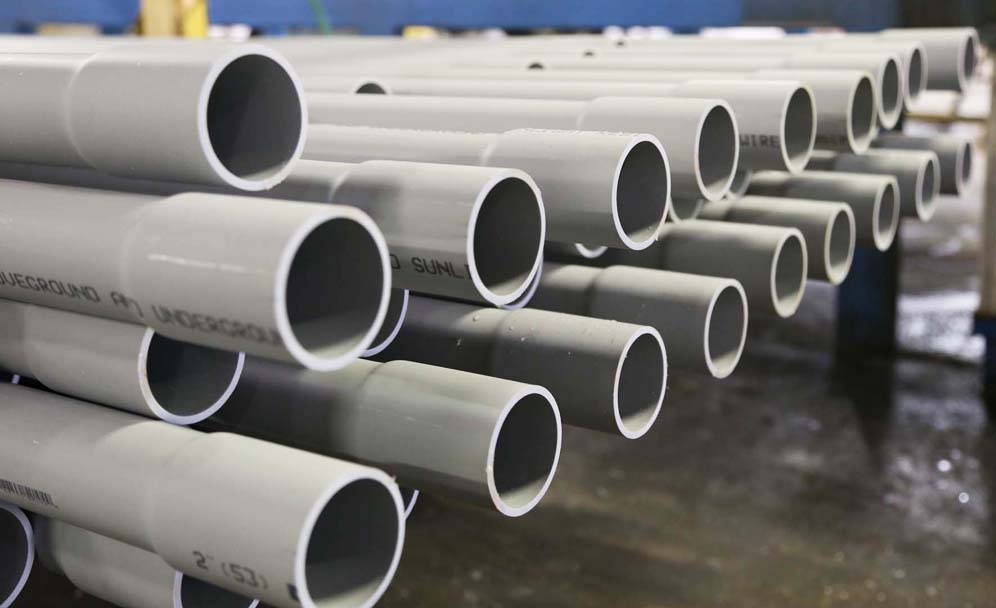CANTEX PVC PIPE IN THE NEWS

November, 2020
By Kara Bowlin - Conduit is a mighty mainstay of the electrical distributor’s catalog. Simple and straightforward, both steel and PVC conduit have become an important asset during the pandemic as reliance on Internet-enabled devices has skyrocketed.
In fact, according to Dave Milius, vice president of sales and marketing at CANTEX (cantexinc.com), many of the markets served by the company are soaring. “Some of it is supporting infrastructure, including roadways and wastewater treatments plants,” he explained, adding that a lot of the company’s business today is also going to new data center construction. “The need for more bandwidth and more data continues to accelerate.”
Milius also noted that the construction forecast for PVC piping and fittings shows a 10% increase over the next four to five years. “So it hasn’t slowed down; if anything, it’s accelerated for us,” he said.
Ramiro Rodriguez Agusti, vice president, commercial conduit, at Nucor/ Republic Conduit (nucortubular.com), noted that, in his experience, the non-residential commercial space continues to lead the charge in demand for conduit and raceway.
“That market space has continued to increase its share of conduit consumed in the country. EMT conduit is usually deployed on those types of projects, where raceway performance and aesthetics are equally important,” he explained.
“The steel conduit space will continue to focus on the areas in which it brings the most value: heavy conductor protection, resiliency, durability, and flexibility for building needs and EMI protection, all with the added bonus of aesthetic appeal,” continued Rodriguez Agusti. “Those features are at the core of the product value proposition and will never go out of style. And in terms of trends across all electrical products, any solution geared to saving time in the field (installation) will generate some market traction.”
Rodriguez Agusti added that a major benefit of steel conduit is its flexibility. “Steel conduit is adaptable to changing building needs,” he said. “For instance, when one commercial tenant of a building leaves and a new one arrives, the changes required to serve the needs of the new tenant could potentially be deployed with the steel conduit already installed. Other raceway solutions would have to be stripped out and discarded, while steel conduit can be reused.”
Trends to Watch
While conduit remains in high demand, manufacturers are continuing to innovate and improve offerings.
“One of the trends we see is the increased use of color conduit,” said Rodriguez Agusti. “Different applications require a wider array of colors. It’s no longer just ‘red and blue.’ For a while, this market space was niche—i.e., small and dedicated to specific uses—but is becoming more wide-spread.” Rodriguez Agusti also noted that steel conduit continues to offer value in resiliency, protection, and durability in contrast to other electrical raceways.
Milius, however, has seen a movement toward PVC conduit products. “They are cost effective; they’re easy to install,” he said. “And they meet the specs necessary to protect the wires and cables needed for entire electrical infrastructures. In the past, a contractor may have used steel for certain projects, but a lot of those applications have started to move toward PVC.”
Milius explained that PVC’s high-impact tensile strength and resistance to chemicals, acids, and salt make it a perfect choice for underground applications. “The biggest recent innovation in conduit is probably in the area of horizontal drilling,” he explained. “Today, we offer products like our CAN>LOC and CAN>GRIP conduit systems that are easily connected together without cement or fusion and can be installed by boring under-ground without digging a trench. You can drill a hole under concrete slabs or driveways or even highways and rivers and then pull the conduit underground through the hole without disturbing what is above it.”
Milius noted that this type of under-ground boring is especially useful in a lot of urban projects and protected natural habitats as electrical utilities move from overhead to underground. “It can save time and money because it doesn’t require extra staff or time for trenching or transporting reels to and from project sites. As a result, the demand for these products is growing exponentially,” he said.